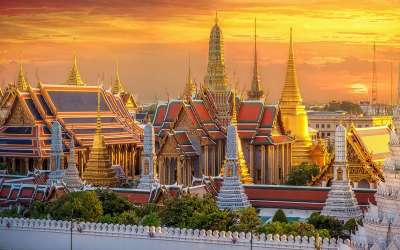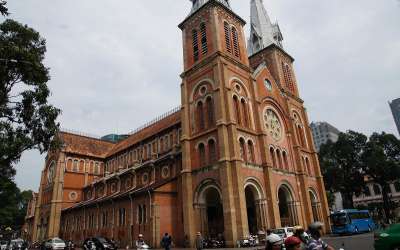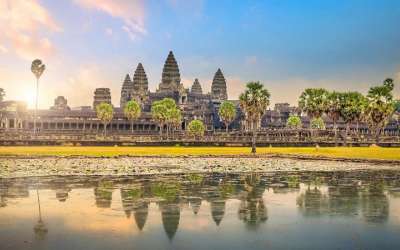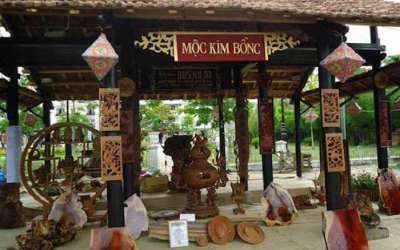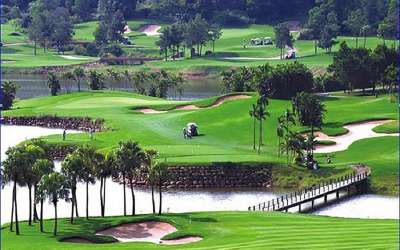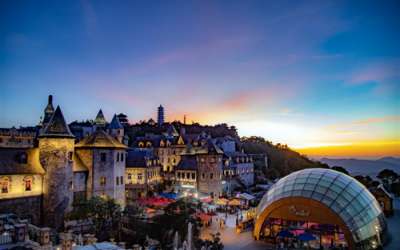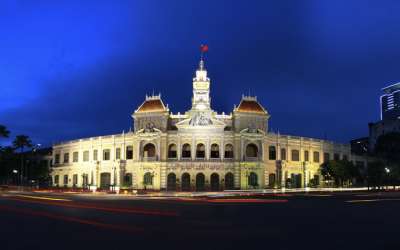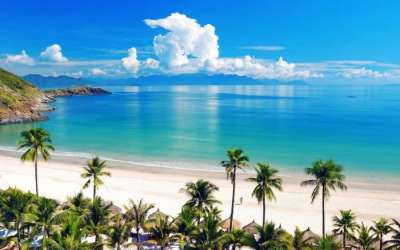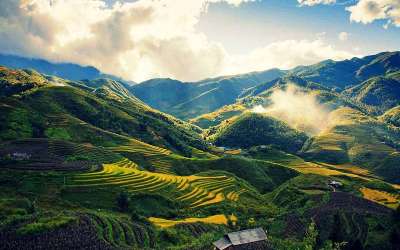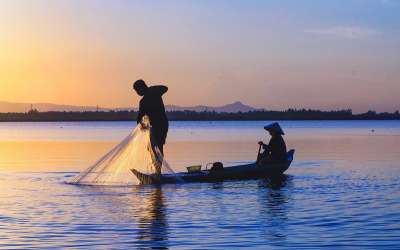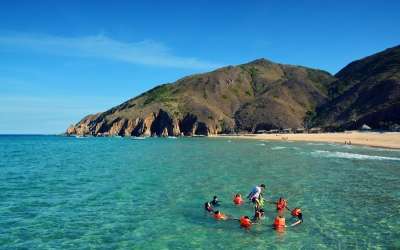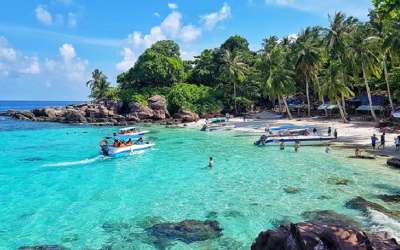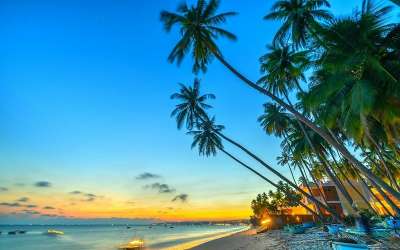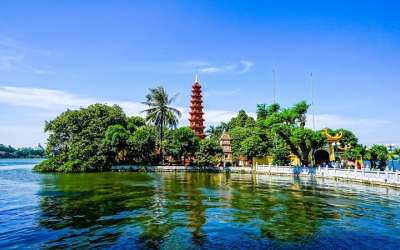
Explore Our Cambodia - Kingdom of Wonder
Stretching across the plains that were once the home of the mighty Khmer Empire, Cambodia is the place that has magnificent ancient civilizations and devastating political tragedies. The incomparable relics in the scale and grandeur of Angkor Wat Complex are the clearest images of the mightiness of the Khmer Empire during the Angkor period. Joining Our Cambodia Tours, you'll find plenty of attractions in Cambodia, from pristine beaches with unique landscapes such as Occheuteal Beach, Sokha Beach, and Victory Beach in Sihanoukville, to trekking through pristine forests in Phnom Kulen National Park to visit the archaeological site of Kbal Spean, also known as 'The River of a Thousand Lingas', explore the vestiges of the ancient capital of Khmer Empire on the top of Kulen mount and enjoy cool feeling of the Phnom Kulen waterfall from the headwaters. Or you can experience by boat on Tonlé Sap Lake - the largest freshwater lake in Southeast Asia and was recognized by UNESCO as a World Biosphere Reserve in 1997, visiting the Royal Palace of Cambodia in Phnom Penh capital which is an indispensable sightseeing spot on the exploring journey in Cambodia, etc. Actually, Cambodia is still very new. Many of Cambodia's mysterious places have not been explored yet. Let us show you where to go.
| Capital City: Phnom Penh | Cambodia Area: 181,035 km² | Cambodia Population: 16,700,502 people | Ethnic Groups: 21 | ||||
| Cities: 25 | World Heritage Sites: 3 | Intangible Cultural Heritage Sites: 2 | The World Biosphere Reserves: 1 |
Travel Guide
1. Why to travel to Cambodia ?
1. MAGNIFICIENT AND AWESOME ANGKOR WAT RUINS
Without a doubt, the biggest draw to attract tourists to Cambodia is absolutely Angkor Wat, the largest religious monument in the world and this is one of the most amazing sites that you may ever see in your life and is a must for all world travelers for many reasons. Standing at the centre of national pride – Cambodia and Afghanistan are the only countries that bare buildings on their state flag – the religious structure dates back to the 12th century, and it was once at the centre of the glorious Angkor Empire. The sprawling temple complex is an architectural feat and home to a series of stunning structures and religious monuments.
2. REMOTE ISLANDS
While the masses flock to neighbouring Thailand’s islands, Cambodia’s alternatives are often wrongly forgotten. That makes them unspoilt options, with the majority maintaining their authenticity and remaining off the mass tourism map. Koh Rong holds the crown as the party island, with nearby Koh Rong Samloem boasting pristine powder sands flanked by tropical flora. Other remote jewels include Koh Thmei, Koh Ta Kiev and Koh Totang.
3. ART DECO BARS AND CAFES
Believe it or not, Phnom Penh is emerging as one of South-East Asia’s most exciting nightlife destinations, thanks to its cheap riverside cafés and innovative bars, such as the tuk-tuk bars you’ll spot in the Bassac Lane area. Despite lacking a national art gallery, the art scene is thriving in Cambodia, with a wave of young contemporary artists leading the way. Galleries sit throughout the capital and Siem Reap, as well as the artistic capital of Battambang and a handful in Kampot.
4. GREAT HOSPITALITY AND WELCOMING LOCALS
Cambodians are incredibly proud of their country’s recovery, and are keener than ever to show the wider world that it’s very much open for business. So, mingle with locals where possible, whether it’s by booking a dinner at one of Siem Reap’s many NGO-funded training restaurants, or with a visit to one of the country’s social enterprises. One of the best is Phare, a Siem Reap-based performance troupe and social enterprise set up to offer local youth training and employment.
5. CONVENIENT ACCESS TO NEIGHBOURING COUNTRIES
Cambodia makes the ideal base for an overland exploration of its neighbours – namely Laos, Thailand and Vietnam – and it’s easy to combine all these destinations on a single trip. Many itineraries visit the capital cities of three South-East Asian countries - Bangkok, followed by the beautiful Vietnamese capital of Hanoi and Cambodia’s riverside capital, Phnom Penh. This is also a good way to experience the colourful chaos of a border crossing, when you drive across the border from Vietnam into Cambodia, or into Thailand. Flights will link you too, but nothing beats the excitement of driving overland into a new country.
6. LIVELY MARKETS
From Siem Reap to Phnom Penh, bustling markets are found all over the country. Stalls are packed full with everything from sneakers to produce. It's close quarters in most markets - the corridors are narrow, space is limited and bodies are everywhere.
7. PREAH VIHEAR TEMPLE - THE UNESCO WORLD HERITAGE SITE
Situated on the edge of a plateau that dominates the plain of Cambodia, the Temple of Preah Vihear is dedicated to Shiva. The Temple is composed of a series of sanctuaries linked by a system of pavements and staircases over an 800 metre long axis and dates back to the first half of the 11th century AD. Nevertheless, its complex history can be traced to the 9th century, when the hermitage was founded. This site is particularly well preserved, mainly due to its remote location. The site is exceptional for the quality of its architecture which is adapted to the natural enviroment and the religious function of the temple, as well as for the exceptional quality of its carved stone ornamentation.
8. MAYBE THE WEATHER
If you are heat seekers, Cambodia will be the best place to get sun-tanned. The temperature ranges from about 25°C to 40°C, depending on what time of the year you visit. .There are two distinct seasons - dry (October to late April) and wet (May to late September). Within each season there are variations in temperature with the final dry months leading up to the wet season (March and April) and the early months of the wet season (May and June) usually being the hottest of the year with temperature in excess of 35°C at times. It is very humid during March and April while the coolest months are usually between October and December, however what is considered “cool” for Cambodia is far from chilly (avg temperatures 24°C – 26°C). Despite having two distinct weather seasons you can travel in Cambodia all-year-round.
9. GREAT LAKE "TONLE SAP" AND FLOATING VILLAGES
The largest body of fresh water in Cambodia in the Tonle Sap Lake. Merging with the Mekong River via the Tonle Sap River, the lake provides economic resources for nearby residents who fish the waters and farm surrounding land providing food for much of the country. Do not miss a visit to one of the floating villages located at the edge of Tonle Sap Lake. This is an incredible experience and an up close look at the daily lives of some Cambodian residents. Houses, markets, schools and even animal pens are built on stilts rising out of the water and the only means of transportation are small boats. These floating villages portray a lifestyle few experience. The better known villages are Kampong Phluk, Kampong Kheleang and Chong Khneas.
10. AN ABUNDANCE OF ADVENTURES
If you love outdoor and adventure, Cambodia will be a great place for you to go. You can experience rural life and stunning landscapes filled with rice paddies, pepper plantations in towns like Kampot. You can also do a lot of island hopping. Here you can spend your days snorkeling, stand up paddleboarding, kayaking, swimming with plankton, boat trips, lying in a hammock, exploring the jungle, hiking to lighthouses. Inland country, the Cardamon Mountains lie inland close to the South Coast. They are part of a vast wilderness and the last of untouched rainforests in South East Asia. Home to some of Cambodia’s elusive wildlife and a gateway to emerging ecotourism adventures. Last but not least we can not forget the famous Mekong river - the river cuts through Cambodia, and provides a home to some of the rarest animals in the world. The Mekong River Irrawaddy Dolphins. Various scenic tours can be taken from Kratie to help you try to spot one of these species. If you love wildlife adventure, Northwest of Cambodia is the ideal place - home to Cambodia’s ethic minorities and wildlife.
Without a doubt, the biggest draw to attract tourists to Cambodia is absolutely Angkor Wat, the largest religious monument in the world and this is one of the most amazing sites that you may ever see in your life and is a must for all world travelers for many reasons. Standing at the centre of national pride – Cambodia and Afghanistan are the only countries that bare buildings on their state flag – the religious structure dates back to the 12th century, and it was once at the centre of the glorious Angkor Empire. The sprawling temple complex is an architectural feat and home to a series of stunning structures and religious monuments.
2. REMOTE ISLANDS
While the masses flock to neighbouring Thailand’s islands, Cambodia’s alternatives are often wrongly forgotten. That makes them unspoilt options, with the majority maintaining their authenticity and remaining off the mass tourism map. Koh Rong holds the crown as the party island, with nearby Koh Rong Samloem boasting pristine powder sands flanked by tropical flora. Other remote jewels include Koh Thmei, Koh Ta Kiev and Koh Totang.
3. ART DECO BARS AND CAFES
Believe it or not, Phnom Penh is emerging as one of South-East Asia’s most exciting nightlife destinations, thanks to its cheap riverside cafés and innovative bars, such as the tuk-tuk bars you’ll spot in the Bassac Lane area. Despite lacking a national art gallery, the art scene is thriving in Cambodia, with a wave of young contemporary artists leading the way. Galleries sit throughout the capital and Siem Reap, as well as the artistic capital of Battambang and a handful in Kampot.
4. GREAT HOSPITALITY AND WELCOMING LOCALS
Cambodians are incredibly proud of their country’s recovery, and are keener than ever to show the wider world that it’s very much open for business. So, mingle with locals where possible, whether it’s by booking a dinner at one of Siem Reap’s many NGO-funded training restaurants, or with a visit to one of the country’s social enterprises. One of the best is Phare, a Siem Reap-based performance troupe and social enterprise set up to offer local youth training and employment.
5. CONVENIENT ACCESS TO NEIGHBOURING COUNTRIES
Cambodia makes the ideal base for an overland exploration of its neighbours – namely Laos, Thailand and Vietnam – and it’s easy to combine all these destinations on a single trip. Many itineraries visit the capital cities of three South-East Asian countries - Bangkok, followed by the beautiful Vietnamese capital of Hanoi and Cambodia’s riverside capital, Phnom Penh. This is also a good way to experience the colourful chaos of a border crossing, when you drive across the border from Vietnam into Cambodia, or into Thailand. Flights will link you too, but nothing beats the excitement of driving overland into a new country.
6. LIVELY MARKETS
From Siem Reap to Phnom Penh, bustling markets are found all over the country. Stalls are packed full with everything from sneakers to produce. It's close quarters in most markets - the corridors are narrow, space is limited and bodies are everywhere.
7. PREAH VIHEAR TEMPLE - THE UNESCO WORLD HERITAGE SITE
Situated on the edge of a plateau that dominates the plain of Cambodia, the Temple of Preah Vihear is dedicated to Shiva. The Temple is composed of a series of sanctuaries linked by a system of pavements and staircases over an 800 metre long axis and dates back to the first half of the 11th century AD. Nevertheless, its complex history can be traced to the 9th century, when the hermitage was founded. This site is particularly well preserved, mainly due to its remote location. The site is exceptional for the quality of its architecture which is adapted to the natural enviroment and the religious function of the temple, as well as for the exceptional quality of its carved stone ornamentation.
8. MAYBE THE WEATHER
If you are heat seekers, Cambodia will be the best place to get sun-tanned. The temperature ranges from about 25°C to 40°C, depending on what time of the year you visit. .There are two distinct seasons - dry (October to late April) and wet (May to late September). Within each season there are variations in temperature with the final dry months leading up to the wet season (March and April) and the early months of the wet season (May and June) usually being the hottest of the year with temperature in excess of 35°C at times. It is very humid during March and April while the coolest months are usually between October and December, however what is considered “cool” for Cambodia is far from chilly (avg temperatures 24°C – 26°C). Despite having two distinct weather seasons you can travel in Cambodia all-year-round.
9. GREAT LAKE "TONLE SAP" AND FLOATING VILLAGES
The largest body of fresh water in Cambodia in the Tonle Sap Lake. Merging with the Mekong River via the Tonle Sap River, the lake provides economic resources for nearby residents who fish the waters and farm surrounding land providing food for much of the country. Do not miss a visit to one of the floating villages located at the edge of Tonle Sap Lake. This is an incredible experience and an up close look at the daily lives of some Cambodian residents. Houses, markets, schools and even animal pens are built on stilts rising out of the water and the only means of transportation are small boats. These floating villages portray a lifestyle few experience. The better known villages are Kampong Phluk, Kampong Kheleang and Chong Khneas.
10. AN ABUNDANCE OF ADVENTURES
If you love outdoor and adventure, Cambodia will be a great place for you to go. You can experience rural life and stunning landscapes filled with rice paddies, pepper plantations in towns like Kampot. You can also do a lot of island hopping. Here you can spend your days snorkeling, stand up paddleboarding, kayaking, swimming with plankton, boat trips, lying in a hammock, exploring the jungle, hiking to lighthouses. Inland country, the Cardamon Mountains lie inland close to the South Coast. They are part of a vast wilderness and the last of untouched rainforests in South East Asia. Home to some of Cambodia’s elusive wildlife and a gateway to emerging ecotourism adventures. Last but not least we can not forget the famous Mekong river - the river cuts through Cambodia, and provides a home to some of the rarest animals in the world. The Mekong River Irrawaddy Dolphins. Various scenic tours can be taken from Kratie to help you try to spot one of these species. If you love wildlife adventure, Northwest of Cambodia is the ideal place - home to Cambodia’s ethic minorities and wildlife.
2. Visa Requirement to Cambodia ?
You will need a valid passport and a Cambodian visa to enter Cambodia. Tourist and business visas are valid for one month from the date of entry into Cambodia. Cambodia offers on-line visa processing. You may also apply in person at the Cambodian Embassy or consulate offices in your country.
Tourists and business travelers may also obtain a Cambodian visa at the airports in Phnom Penh, Siem Reap and at all major border crossings. Cambodian immigration officials at airports now collect fingerprints upon entry using an inkless, electronic process. You will need two passport-sized (4cm by 6cm) photographs and a passport valid for a minimum of six months beyond the date of entry into Cambodia.
If you remain in Cambodia beyond the date of your authorized stay, Cambodian immigration officials will impose a fine of $10 per day overstayed. In cases of excessive overstays, you may be arrested for violating immigration laws, and detained as you undergo official deporation proceedings at your own expense. Deportation from Cambodia may result in your being probihited from reentering Cambodia in the future.
Tourists and business travelers may also obtain a Cambodian visa at the airports in Phnom Penh, Siem Reap and at all major border crossings. Cambodian immigration officials at airports now collect fingerprints upon entry using an inkless, electronic process. You will need two passport-sized (4cm by 6cm) photographs and a passport valid for a minimum of six months beyond the date of entry into Cambodia.
If you remain in Cambodia beyond the date of your authorized stay, Cambodian immigration officials will impose a fine of $10 per day overstayed. In cases of excessive overstays, you may be arrested for violating immigration laws, and detained as you undergo official deporation proceedings at your own expense. Deportation from Cambodia may result in your being probihited from reentering Cambodia in the future.
3. Weather in Cambodia ?
Kingdom of Cambodia is blessed with one of Asia's simpler weather systems. The country has two distinct weather seasons, but you can travel in Cambodia all year around. In general, the entire country is subject to the same weather patterns, mainly due to the relatively uniform altitude and latitude throught Cambodia.
There are two distinct seasons - dry (October to late April) and wet (May to late September). Within each season there are variations in temperature, with the final few dry months leading up to the wet season (March and April) and the early months of the wet season (May and June) usually being the hottest of the year with temperatures in excess of 35°C at times.
Humidity is at its highest during March and April whilst the coolest months of year tend to be between October and December, however this is cool for Cambodia but far from chilly with average temperatures hovering around 24°C-26°C.
There are two distinct seasons - dry (October to late April) and wet (May to late September). Within each season there are variations in temperature, with the final few dry months leading up to the wet season (March and April) and the early months of the wet season (May and June) usually being the hottest of the year with temperatures in excess of 35°C at times.
Humidity is at its highest during March and April whilst the coolest months of year tend to be between October and December, however this is cool for Cambodia but far from chilly with average temperatures hovering around 24°C-26°C.
4. Best time to visit Cambodia ?
The best time to visit Cambodia depends on the heat, rainfall and number of tourists. Most travelers visit Cambodia from November to March. If you prefer to dolge the crowds and go when prices are lower, the best time to visit Cambodia is from May to early October.
5. What are the most remarkable landmarks in Cambodia ?
Angkor Temples
Nothing can win over Angkor Temples, when metioning about the landmark of Cambodia. It is the remain of the once-glory Khmer Empire and holds an exceptional cultural value. This temple complex is so significant with the locals that is has been inscribed Cambodian National Flag which is used in all political, economic and social events worldwide.
Mekong River
Flowing across the land of 6 countries, the Mekong, the world's 12th longest river is the wellspring of the local people. It not only plays as a supply of water and food but also be a significant transportation system and tourist destination.
Travelers taking luxury Cambodia tours love to go aboard a Mekong Cruise to spot the dolphin, observe the wildlife, visit the floating villages and enjoy the sunset.
Phnom Kulen Waterfalls - Phnom Kulen National Park
The mighty waterfalls in Phnom Kulen National Park is another pride of Cambodian people. The waterfalls tumble down the summer heat.
Koh Rong
Koh Rong is the real paradise for beach-goers thank to its crystal-clear water and Colgate - white sandbanks. It's a great destination for swimming, sunbathing and other water sports.
Koh Rong Samloem - Koh Rong's sister island is another appealing destination in Cambodia. There are a series of high-end resorts alongside the deserted beaches, offering tourists a chance to blow away your stress and fatigue and refersh yourselves.
Nothing can win over Angkor Temples, when metioning about the landmark of Cambodia. It is the remain of the once-glory Khmer Empire and holds an exceptional cultural value. This temple complex is so significant with the locals that is has been inscribed Cambodian National Flag which is used in all political, economic and social events worldwide.
Mekong River
Flowing across the land of 6 countries, the Mekong, the world's 12th longest river is the wellspring of the local people. It not only plays as a supply of water and food but also be a significant transportation system and tourist destination.
Travelers taking luxury Cambodia tours love to go aboard a Mekong Cruise to spot the dolphin, observe the wildlife, visit the floating villages and enjoy the sunset.
Phnom Kulen Waterfalls - Phnom Kulen National Park
The mighty waterfalls in Phnom Kulen National Park is another pride of Cambodian people. The waterfalls tumble down the summer heat.
Koh Rong
Koh Rong is the real paradise for beach-goers thank to its crystal-clear water and Colgate - white sandbanks. It's a great destination for swimming, sunbathing and other water sports.
Koh Rong Samloem - Koh Rong's sister island is another appealing destination in Cambodia. There are a series of high-end resorts alongside the deserted beaches, offering tourists a chance to blow away your stress and fatigue and refersh yourselves.
6. Best Beaches in Cambodia ?
Even though this Khmer land is not so famous for its coastline and islands, there are still jaw-dropping places for beach lovers to explore. Indeed, as most people travel to Cambodia not for its beaches, the beaches in this country still remain its untouched beauty and quiteness, thus being even more appealing to tourists. The south and southwest of Cambodia offer quite a number of beautiful beaches and the following there are the ones that are loved the most.
Saracen Bay Beach, Koh Rong Samloem
Koh Rong Samloem is indeed an untouched paradise that boasts pristine beach with soft sugar-white sand and surrounded by palm trees. Saracen Bay is an enclosed bay that features awe-inspring beach and rock-free water which are perfect for swimming and basking in the sunshine. Less crowded and noisy than the popular Koh Rong Island, this small island is definitely a better place for a summer gateaway.
Independence Beach, Sihanoukville
The Independence Beach stands out among the long lists of beaches in Sihanoukville thanks to its quiet vibe. This beach is more than 1 kilometers long, a part of which has been taken over by a private resort. It is so mesermizing an experience to walk along the quiet beach at the sunset with your loved one while enjoying the unspoiled beauty of Mother Nature. In addition, the right comforting warmth is just perfect for swimming and diving.
Otres Beach, Sihanoukville
Another must-mention name is Otres Beach which is also located in Sihanoukville. If your joy is to soothe the sand. Otres is where you should go. Processing sun-kissed sandbank and transparent blue sea water, the beach is amazing whenever you look at day or night, at dawn or at twilight, in the morning fog or under the moonlight. Diferent times of the day provide you with different emotions and experiences. Undoubtely, Otres Beach deserves to be a top place for luxury escapes in Cambodia.
Saracen Bay Beach, Koh Rong Samloem
Koh Rong Samloem is indeed an untouched paradise that boasts pristine beach with soft sugar-white sand and surrounded by palm trees. Saracen Bay is an enclosed bay that features awe-inspring beach and rock-free water which are perfect for swimming and basking in the sunshine. Less crowded and noisy than the popular Koh Rong Island, this small island is definitely a better place for a summer gateaway.
Independence Beach, Sihanoukville
The Independence Beach stands out among the long lists of beaches in Sihanoukville thanks to its quiet vibe. This beach is more than 1 kilometers long, a part of which has been taken over by a private resort. It is so mesermizing an experience to walk along the quiet beach at the sunset with your loved one while enjoying the unspoiled beauty of Mother Nature. In addition, the right comforting warmth is just perfect for swimming and diving.
Otres Beach, Sihanoukville
Another must-mention name is Otres Beach which is also located in Sihanoukville. If your joy is to soothe the sand. Otres is where you should go. Processing sun-kissed sandbank and transparent blue sea water, the beach is amazing whenever you look at day or night, at dawn or at twilight, in the morning fog or under the moonlight. Diferent times of the day provide you with different emotions and experiences. Undoubtely, Otres Beach deserves to be a top place for luxury escapes in Cambodia.
7. Top Cambodia Tourist Attractions?
Siem Reap (Angkor Wat)
Definitely, Siem Reap, the hometown of Angkor is a cannot-miss destination for any Cambodia travel. The temple complex of Angkor Wat is the landmark of this Khmer country, which is even inscribed on its national flag. Not only does it hold significant cultural value, Angkor is a masterpiece of ancient architecture, also.
Aside from this worldwide famous heritage, Siem Reap has more to offer. There is a bustling town admist the city, where you can tape a sip of beer or liquor while swaying your hips with the fancy music. Besides, tourists can head to Phnom Kulen National Park to admire the screaming waterfalls, observe the wildlife, visit the sacred shrines and temples high on the mountains and take an exquisite view over the whole region.
Phnom Penh
The capital of Cambodia is another place to visit, especially for history buffs. Don't miss delving into the past of this city if you want to learn more Cambodian tough years. Here you can see with your bare eyes the traces of Khmer Rouge which mimic how millions of Cambodian people were killed brutally during this devil regime.
Tonle Sap
Nestled in the northwest of Cambodia, Tonle Sap is the largest freshwater lake in Southeast Asia. The size of the lake varies from 3,000 square kilometers (in the dry seasons) to 10,000 square kilometers (in the west seasons). It is home to more than 3 million people, most of whom earn a living by fishing and farming.
Travelers can take a tour to Tonle Sap to visit the floating villages, where the indigenous locals live on stilt houses above the water surface. You can explore the flooded forests if coming in the rainy season, also.
Koh Rong
Thanks to the untouched beauty. Koh Rong and its sister land - Koh Rong Samloem have become top destinations for beach lovers. The islands boast streching sugar-white beaches, turquoise sea water and pleasant climate which are ideal for you to bask in the sunshine by day and have a toast at night.
If you love to have fancy times, visit the popular beach in Koh Rong. But if you seek a much more tranquil for a leisure stay, luxury resorts on Koh Rong Samloem is where you should head to.
Krong Kep
Kep is a small yet beautiful coastal town that used to be the top beachside destination of Cambodia during the colonial period. Around the town still exist several old western-style villas of the French colonialists and the ruins of Khmer Rouge.
Aside from the empty golden sand beaches. Kep is now more renowned for Kep National Park, the home to a diverse bio-ecosystem. It is a great place for trekking, sightseeing and photography.
Bokor Hill Station
Located in Kampot, Bokor Hill Station was constructed to become a luxurious retreat of the colonizers in the past but abandoned multiple times during the war. Recently, the place has started to re-develop and become a must-see destination for Cambodia tours.
If you seek for thrilling experiences, Bokor is a must-see. Aside from exploring the abandoned buildings, hiking up the mountain in the National Park interesting to try. The panoramic view from there would definitely make your jaw drop.
Definitely, Siem Reap, the hometown of Angkor is a cannot-miss destination for any Cambodia travel. The temple complex of Angkor Wat is the landmark of this Khmer country, which is even inscribed on its national flag. Not only does it hold significant cultural value, Angkor is a masterpiece of ancient architecture, also.
Aside from this worldwide famous heritage, Siem Reap has more to offer. There is a bustling town admist the city, where you can tape a sip of beer or liquor while swaying your hips with the fancy music. Besides, tourists can head to Phnom Kulen National Park to admire the screaming waterfalls, observe the wildlife, visit the sacred shrines and temples high on the mountains and take an exquisite view over the whole region.
Phnom Penh
The capital of Cambodia is another place to visit, especially for history buffs. Don't miss delving into the past of this city if you want to learn more Cambodian tough years. Here you can see with your bare eyes the traces of Khmer Rouge which mimic how millions of Cambodian people were killed brutally during this devil regime.
Tonle Sap
Nestled in the northwest of Cambodia, Tonle Sap is the largest freshwater lake in Southeast Asia. The size of the lake varies from 3,000 square kilometers (in the dry seasons) to 10,000 square kilometers (in the west seasons). It is home to more than 3 million people, most of whom earn a living by fishing and farming.
Travelers can take a tour to Tonle Sap to visit the floating villages, where the indigenous locals live on stilt houses above the water surface. You can explore the flooded forests if coming in the rainy season, also.
Koh Rong
Thanks to the untouched beauty. Koh Rong and its sister land - Koh Rong Samloem have become top destinations for beach lovers. The islands boast streching sugar-white beaches, turquoise sea water and pleasant climate which are ideal for you to bask in the sunshine by day and have a toast at night.
If you love to have fancy times, visit the popular beach in Koh Rong. But if you seek a much more tranquil for a leisure stay, luxury resorts on Koh Rong Samloem is where you should head to.
Krong Kep
Kep is a small yet beautiful coastal town that used to be the top beachside destination of Cambodia during the colonial period. Around the town still exist several old western-style villas of the French colonialists and the ruins of Khmer Rouge.
Aside from the empty golden sand beaches. Kep is now more renowned for Kep National Park, the home to a diverse bio-ecosystem. It is a great place for trekking, sightseeing and photography.
Bokor Hill Station
Located in Kampot, Bokor Hill Station was constructed to become a luxurious retreat of the colonizers in the past but abandoned multiple times during the war. Recently, the place has started to re-develop and become a must-see destination for Cambodia tours.
If you seek for thrilling experiences, Bokor is a must-see. Aside from exploring the abandoned buildings, hiking up the mountain in the National Park interesting to try. The panoramic view from there would definitely make your jaw drop.
8. How to get to Cambodia ?
There are no direct flights to Cambodia from Europe, North America, Australasia or South Africa so if you plan to fly into the country you'll need to get a connecting from elsewhere in Southeast or East Asia.
There are direct flights to Phnom Penh from an increasing number of cities in the region including Kuala Lumper, Singapore, Seoul, Vientiane, Ho Chi Minh Cityand several cities in China (including frequent connections with Hong Kong). Alternatively, it's also impossible to fly direct to Siem Reap from Singapore, Bangkok, Ho Chi Minh City, Kuala Lumper and a number of other Asian destinations.
There are direct flights to Phnom Penh from an increasing number of cities in the region including Kuala Lumper, Singapore, Seoul, Vientiane, Ho Chi Minh Cityand several cities in China (including frequent connections with Hong Kong). Alternatively, it's also impossible to fly direct to Siem Reap from Singapore, Bangkok, Ho Chi Minh City, Kuala Lumper and a number of other Asian destinations.
9. Unusual things to do in Cambodia ?
Wander around a local food market
The best way to feel the "authentic" Cambodia is to visit the local food markets and shops as the locals usually do. In eastern culture, market plays an important role in the life of the locals, and it is not an exception in Cambodia. Event when supermarkets have become popular, markets are still indispensable.
You can find everything in the market, from foods, clothes, daily household furniture to jewelry and gold.
Have a blessing from the Buddhist monk
It would be a big regrets if you leave this religious without having a blessing from the monk. Buddhism is one of the foundations of the Khmer Culture and the locals still keep practicing this religion on a daily basis. Go to the temple, mediate, read the dhrama talks and have a monk to make a blessing for your own. It's a great way to find peace in your mind as well as seek some luck for your life.
Tame the elephants
Cambodia is the land of elephant. A Cambodia tour would give you the opportunity to see the wild elephants with your bare eyes. Not only can you see them, you are also allowed to touch and wash them.
In some projects and sanctuaries, tourists are also able to follow the elephant to the bamboo forest and learn how to tame them.
Seeing elephants might be a fancy thing, but please notice that you should not try to ride them. Even when elephant-riding is now still a legal tourism activity, it is better to reduce their work. Asian elephants are endangered animals and they should be well protected.
The best way to feel the "authentic" Cambodia is to visit the local food markets and shops as the locals usually do. In eastern culture, market plays an important role in the life of the locals, and it is not an exception in Cambodia. Event when supermarkets have become popular, markets are still indispensable.
You can find everything in the market, from foods, clothes, daily household furniture to jewelry and gold.
Have a blessing from the Buddhist monk
It would be a big regrets if you leave this religious without having a blessing from the monk. Buddhism is one of the foundations of the Khmer Culture and the locals still keep practicing this religion on a daily basis. Go to the temple, mediate, read the dhrama talks and have a monk to make a blessing for your own. It's a great way to find peace in your mind as well as seek some luck for your life.
Tame the elephants
Cambodia is the land of elephant. A Cambodia tour would give you the opportunity to see the wild elephants with your bare eyes. Not only can you see them, you are also allowed to touch and wash them.
In some projects and sanctuaries, tourists are also able to follow the elephant to the bamboo forest and learn how to tame them.
Seeing elephants might be a fancy thing, but please notice that you should not try to ride them. Even when elephant-riding is now still a legal tourism activity, it is better to reduce their work. Asian elephants are endangered animals and they should be well protected.
10. Do's and Don't in Cambodia ?
Do's
Dress modestly
It is absoutely fine to get dressed up comfortably or even sexily if you are about to go to a pub in Siem Reap or a pool party at a luxury resort. However, things are not the same if you are about to visit the heritages. Leave your shorts, miniskirts and any other clothes that are above your knees or reveal too much skin at home. Put on a long pant or long dress, instead.
Show cultural respects
It is necessary to show your respects for the Cambodian people and culture. Social class is quite notorious here, so pay attention to your etiquette when meeting the ederly or the monks.
Bargain
That Khmer people are hospitable and honest does not mean you won't be overcharged when shopping in their markets or shops. Bargaining is a must do in almost all Asian countries, not just Cambodia.
Don't
Dress modestly
It is absoutely fine to get dressed up comfortably or even sexily if you are about to go to a pub in Siem Reap or a pool party at a luxury resort. However, things are not the same if you are about to visit the heritages. Leave your shorts, miniskirts and any other clothes that are above your knees or reveal too much skin at home. Put on a long pant or long dress, instead.
Show cultural respects
It is necessary to show your respects for the Cambodian people and culture. Social class is quite notorious here, so pay attention to your etiquette when meeting the ederly or the monks.
Bargain
That Khmer people are hospitable and honest does not mean you won't be overcharged when shopping in their markets or shops. Bargaining is a must do in almost all Asian countries, not just Cambodia.
Don't
- Give money to children and beggars on the streets. Many of these people are forced to do that job and would get nothing even when you give them money. All would come into the wallet of their "boss" instead.
- Talk about sensitive topics. It is never a should talk about politics or war with Cambodian people. Especially, they hate mentioning about Khmer Rouge period, so do not bring them to your conversation.
- Be culture offensive. Many things sound to be exceptionally unrespectful to Cambodian people such as touching someone’s head, using the left hand to give and receive things, pointing your feet to other people or to Buddha’s images, pointing your index finger to others, complaining about their country, and so on.
- Show affection in public. Cambodia is still a conservative society and they tend to avoid interacting with people of the opposite gender when they are in public. Holding hands, hugging, and kissing is unacceptable, too.
- Drink tap water. Tap water is not clean, so avoid drinking it. You can use bottled water instead.
Meet our Expert
Ms. Vui
I’m proud to represent GrandViet Tour and to help you find your perfect vacation. Before you book elsewhere, check with me please! You will receive added benefit of booking with GrandViet Tour as well.
(+84) 098 314 0217 (Viber/Line)
We offer all package tours to Vietnam and Southeast Asia
sales@grandviettour.com
We offer all package tours to Vietnam and Southeast Asia
sales@grandviettour.com
Best destinations in Vietnam



© GrandViet Tour., Co., Ltd. - The Top Inbound Tour Operator in Vietnam organized the biggest number of visitors from Southeast Asia in 2018.
© GrandViet Tour Co., Ltd. - International Tour Operator Licence 01-217/TCDL-GPLHQT.
Copyright © 2006 - 2020. All Rights Reserved.
© GrandViet Tour Co., Ltd. - International Tour Operator Licence 01-217/TCDL-GPLHQT.
Copyright © 2006 - 2020. All Rights Reserved.


